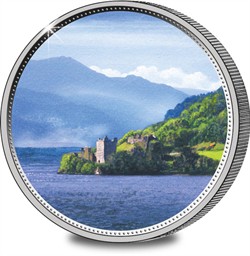-no-button.jpg)
 |
Location: Scottish Highlands, south west of
Inverness
Date built: formed during Caledonian oregony, c. 400 million years
ago
Designers/builders: natural feature
Function: tourist attraction
|
Apart from anything else, Loch Ness is an impressive natural
feature. Although it is the second largest Scottish loch by surface
area after Loch Lomond, its great depth - 755 ft (230 m) at its
deepest point) means it contains more water than every lake in
England and Wales put together and more than any other lake in
Scotland. The great depth means that Loch Ness never freezes. The
reason is that, while the top 100 ft (30 m) of water reacts to the
ambient temperature, below that level the water stays at a constant
44o F. As the surface water cools it sinks and is replaced by
warmer water from the lower level. The Loch is fed by seven major
rivers, while its only outlet is the River Ness, which flows
through Inverness into the Moray Firth.
However, what makes Loch Ness world famous is not its impressive
statistics, but its elusive resident. The Loch Ness Monster (or
"Nessie") has captured the public imagination, even though no
scientifically verified proof of its existence has ever been
obtained. The earliest reported sighting (albeit in the River Ness,
rather than the Loch) was in the 7th century, when St Columba,
using the sign of the cross, drove off a monster terrorising the
local people. In 1933 the building of a road alongside the
Loch brought more people to this hitherto remote area. Later that
year George Spicer and his wife claimed to have seen a 25 ft (7.6
m) long monster crossing the road in front of them. Other sightings
followed, some from respectable observers. In August 1933 a
veterinary student said he had seen the monster and that it was a
cross between a seal and a plesiosaur. In 1938 the Chief Constable
of Inverness-shire, William Fraser, wrote that it was beyond doubt
that the monster existed. In 1954 a fishing boat made sonar
contact with a large object at a depth of 480 ft. Over the years,
several expeditions, often with elaborate detection equipment -
including one by the BBC in 2003 - have been mounted to seek out
Nessie, but none has provided convincing proof. However, the legend
adds to the spice of life and provides a steady stream of visitors
to the area, so long may Nessie thrive.